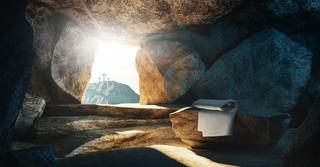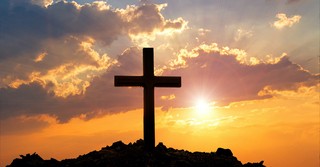Do We Know Where Jesus Was Buried?
Share

Several years ago, a team of archaeologists and other scientists were given permission to remove the marble cladding around the burial shelf in the Church of the Holy Sepulchre in Jerusalem. There was much excitement around their exploration of the tomb where many people believe the body of Jesus once lay.
There is debate, however, around the authenticity of the site. Two other locations in Jerusalem have been proposed as the “real” burial places of Jesus. What does the Bible tell us about Jesus’ burial?
The gospels tell us that Jesus’ body lay in the tomb of Joseph of Arimathea from the day He was crucified until the day He rose from the dead (Matthew 27:58-60).
Where Does the Bible Say Jesus Was Buried?
After Jesus’ crucifixion, Joseph of Arimathea asked Pilate for Jesus’ body (Mark 15:43). His request was granted, and Matthew 27:59-60 says,
“Joseph took the body, wrapped it in a clean linen cloth, and placed it in his own new tomb that he had cut out of the rock. He rolled a big stone in front of the entrance to the tomb and went away.”
We learn in John 19:39 that another disciple named Nicodemus accompanied Joseph and brought 75 pounds of “a mixture of myrrh and aloes.” Myrrh and aloes were costly spices used for embalming. Such an extravagant amount honored Jesus as a king.
The two men wrapped some of the spices in with Jesus’ body during the hasty burial. When the Jewish Sabbath began at sundown, work of any kind had to cease.
Two followers of Jesus, Mary Magdalene and Mary the mother of Jesus, watched Joseph of Arimathea to see where he laid the body of Jesus. They went home to prepare spices and perfumes (Luke 23:56), planning to return and complete a more thorough anointing of Jesus’ body at sunrise the day after the Sabbath (Mark 15:47-16:1).
Get your FREE Holy Week Guide here. Have encouragement delivered straight to your inbox!
Photo credit: ©Getty Images/alessandrophoto
Who Was Joseph of Arimathea?

This is not the husband of Jesus’ mother Mary. This Joseph was a rich man (Matthew 27:57) who was originally from Arimathea, a town in Judah (Luke 23:51).
John 19:38 tells us that Joseph of Arimathea was “a disciple of Jesus, but secretly because he feared the Jewish leaders.” Mark 15:43 names him as a “prominent member of the Council.” The Greek word translated as “prominent” also means honorable, noble, influential, and respected. Indeed, Luke 23:50 praises him as “a good and upright man.”
The Council was the supreme court of Judaism also known as the Sanhedrin. It was composed of the chief priests, elders, and teachers of the law, so Joseph of Arimathea was a religious leader.
This is the same Sanhedrin that condemned Jesus as a blasphemer and sentenced Him to death. Joseph, however, had not taken part in the illegal late-night trial where Jesus was falsely accused. At the trial, the Sanhedrin had unanimously agreed that Jesus deserved the death sentence. But Luke 23:51 tells us that Joseph “had not consented to their decision or action.”
Both Luke and Mark describe Joseph as “waiting for the kingdom of God.” The Greek verb used for “wait” here means to eagerly anticipate, to await with confidence. Joseph of Arimathea had been looking for God’s salvation. When Jesus showed up, Joseph recognized the Savior for whom he had waited so long.
Joseph’s decision to give his newly hewn tomb to Jesus was likely based on both a desire to honor Him and simple practicality. Joseph’s tomb was in a garden near the place where Jesus had been crucified. Joseph and Nicodemus were running out of time before sundown. John 19:42 spells it out, “Because it was the Jewish day of Preparation and since the tomb was nearby, they laid Jesus there.”
Photo credit: ©Getty Images/kckate16
Where Is Jesus' Tomb Located Today?

Three tombs in Jerusalem have been touted as possibilities: the Talpiot Family Tomb, the Garden Tomb (sometimes called Gordon’s Tomb), and the Church of the Holy Sepulchre.
The Talpiot tomb was discovered in 1980 and gained fame when featured in the 2007 documentary The Lost Tomb of Jesus. However, the evidence presented by the filmmakers has since been discredited. Moreover, scholars have pointed out that a poor family from Nazareth would not have owned an expensive rock-cut family tomb in Jerusalem.
The strongest argument against the Talpiot Family Tomb is the filmmakers’ piece de resistance: the bones of Jesus in a stone box marked “Jesus, son of Joseph.” There were many men named Jesus in 1st century BC Judea. It was one of the most common Jewish names of the period. But the Jesus whose bones rest in that stone box is not Jesus of Nazareth, who rose from the dead.
The Garden Tomb was discovered in the late 1800s when British general Charles Gordon pointed out a nearby escarpment that looks like a skull. According to Scripture, Jesus was crucified at “the place called the Skull” (John 19:17), so Gordon believed he had found the location of Jesus’ crucifixion.
Now a popular tourist attraction, the Garden Tomb is indeed in a garden, as was the tomb of Jesus. It is currently outside the walls of Jerusalem, and Jesus’ death and burial took place outside the city walls (Hebrews 13:12). However, scholars have pointed out that the Church of the Holy Sepulchre would also have been outside the city gates until the walls of Jerusalem were expanded in 41-44 BC.
The biggest problem with the Garden Tomb is the layout of the tomb itself. Also, features of the rest of the tombs in the area strongly suggest that it was carved around 600 years or so before Jesus was born. Scholars deem it nearly impossible that the Garden Tomb was “new” at the time of Jesus’ death and burial.
The Church of the Holy Sepulchre is frequently mentioned by archaeologists as the site with the most compelling evidence of authenticity. The archaeological evidence points to this being a Jewish cemetery outside the walls of Jerusalem in the first century.
Eusebius, a 4th-century writer, recorded the history of the Church of the Holy Sepulchre. He wrote that the Roman emperor Constantine sent a delegation to Jerusalem in 325 BC to find the burial place of Jesus. Local tradition at the time held that Jesus’ tomb was under a temple built by the Roman emperor Hadrian after Rome destroyed Jerusalem. When the temple was razed, the Romans discovered the tomb underneath. At Constantine’s orders, they cut away the top of the cave so that people could see into it, then erected a shrine around it.
During recent explorations of the site, dating techniques verified that parts of the church are indeed from the 4th century. Additions were made to the church over the years, including numerous shrines based on legends with no Biblical basis. Scholars caution that there is not sufficient evidence to make a definitive identification of the authentic tomb of Jesus of Nazareth.
Photo credit: ©Getty Images/jchizhe
How Long Was Jesus Buried?

Jesus’ body lay in the tomb from Friday evening before sunset until the pre-dawn hours of Sunday morning, about two and a half days in total by our reckoning.
A first-century Jew would have seen the same time period as representing three days, because part of a day was counted as a whole day in their culture. When the Bible states that He rose “on the third day” (1 Corinthians 15:4), it is counting Friday as the first day, Saturday as the second day, and Sunday as the third day.
All four gospels mention that Jesus died on Preparation Day (Matthew 27:62, Mark 15:42, Luke 23:54, John 19:31). Preparation Day is on Friday, the day before the Jewish Sabbath.
Mark 15:25 tells us that it was the third hour, what we would call 9:00 in the morning, when the Roman soldiers nailed Jesus to the cross. He hung on the cross until about the ninth hour, 3:00 PM, when He died (Matthew 27:45-50).
Matthew 27:57-60 states that Joseph of Arimathea asked Pilate for Jesus’ body “as evening approached” and placed it in the tomb. Jews were not permitted to do any work after sunset on Preparation Day, so it would not yet have been dark when they did this.
The gospel writers all specify that the first people to find out about the resurrection heard the news at dawn on the first day of the week, what we call Sunday (Matthew 28:1, Mark 16:2, Luke 24:1, John 20:1).
Photo credit: Unsplash/Mads Schmidt Rasmussen
Who Were the First People to Arrive at Jesus' Empty Tomb?

As Mary Magdalene, Mary mother of James, and Salome walked toward the tomb on Sunday morning, they worried and talked about who would move the massive stone sealing the entrance. But when they arrived, they were surprised to find that the stone had already been rolled away (Luke 24:1-2).
The women were even more shocked to find that Jesus’ body had disappeared. While they were still standing there, wondering what had happened, an angel of the Lord appeared in white robes that gleamed like lightning and said,
“He is not here; he has risen! Remember how he told you, while he was still with you in Galilee: ‘The Son of Man must be delivered over to the hands of sinners, be crucified and on the third day be raised again’” (Luke 24:6-7).
The women fled from the tomb, terrified and confused. They told the disciples what they had seen, but only Peter and John believed them. After seeing the empty tomb, Peter walked away wondering what on earth had happened. John 20:9 explains that they “still did not understand from Scripture that Jesus had to rise from the dead.”
Mary Magdalene remained at the empty tomb, weeping. She thought someone had stolen her Lord’s body, and she was overcome with grief. When Jesus appeared, she thought He was the gardener and asked Him if He had carried Jesus’ body away.
Then Jesus said her name, “Mary.”
She recognized His voice, turned toward Him, and cried, “Teacher!”
Jesus encouraged her to tell the disciples that He was alive, and she ran to share the good news, “I have seen the Lord!” (John 20:10-18).
Still Good News
Scholars may never conclusively prove which ancient tomb was the authentic burial place of Jesus. Wherever the tomb was or is, it is empty. Jesus Christ has risen, overcoming death so that we may have life.
Related articles
When Did Jesus Die? What Do We Know About the Timeline of Jesus' Death and Resurrection
Did Jesus Actually Descend into Hell?
6 Beautiful Truths about the Crucifixion
Photo credit: ©Getty Images/jgroup
